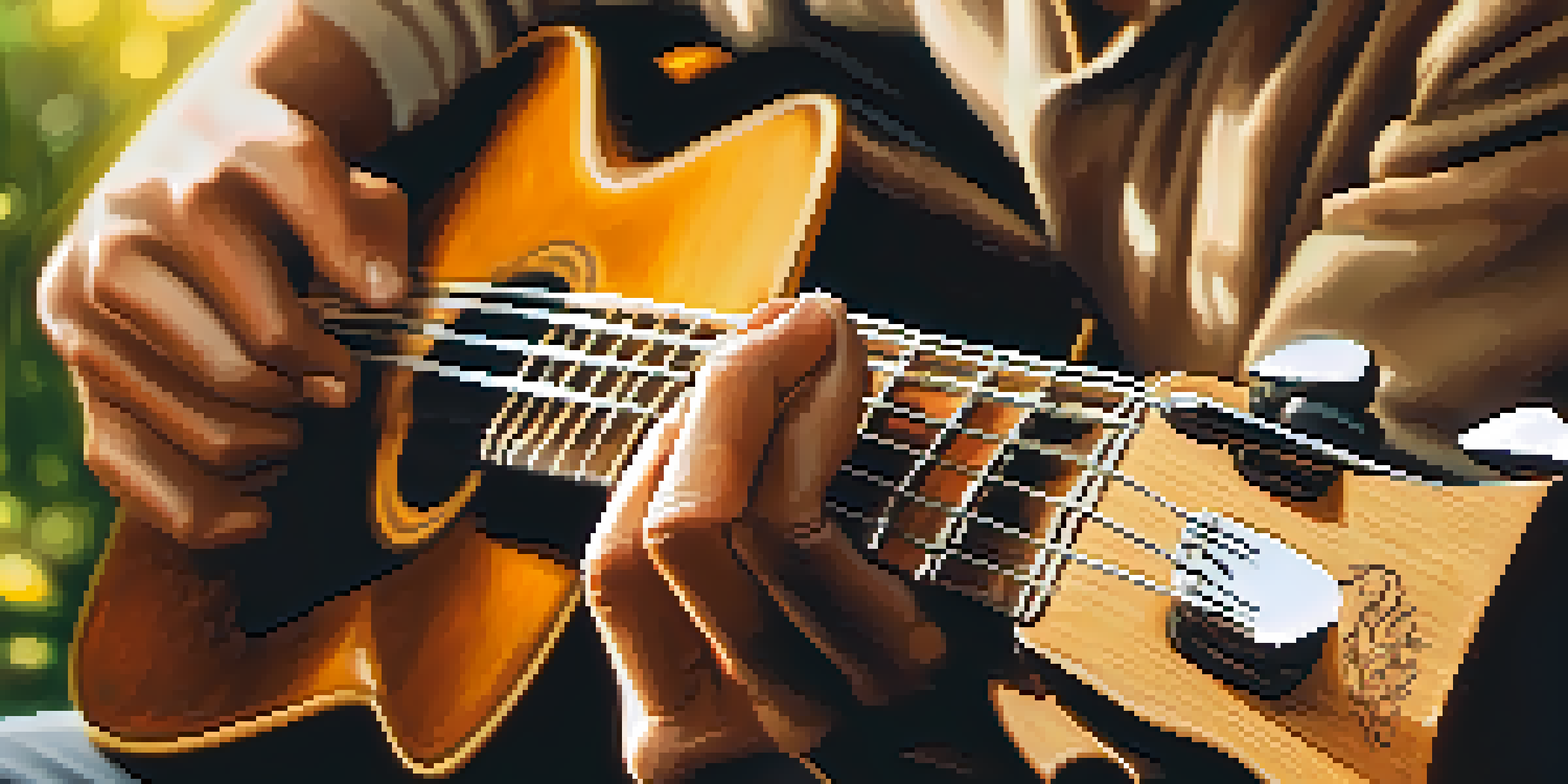Essential Techniques for Guitar Accompaniment to Vocalists

Understanding the Role of Guitar in Vocal Accompaniment
When accompanying a vocalist, the guitar serves as both a harmonic foundation and a rhythmic partner. It’s important to recognize that your role is to support the singer, not overshadow them. Think of the guitar as a gentle breeze that helps carry the voice rather than a thunderstorm that drowns it out.
Music is the shorthand of emotion.
This means you should focus on creating a backdrop that complements the melody and allows the lyrics to shine. Strumming patterns, fingerpicking, and chord choices can all play a significant role in establishing this supportive atmosphere. The key is to listen actively and adapt your playing to what the vocalist needs.
Ultimately, a great accompaniment enhances the overall performance, making it more engaging for the audience. So, as you tune your guitar, also tune your ears to the subtle nuances of the vocalist’s delivery.
Choosing the Right Chords for Different Songs
Selecting the appropriate chords is crucial in setting the mood for a song. Major chords can evoke happiness and brightness, while minor chords often convey sadness or introspection. For example, if a singer is performing an upbeat pop song, bright major chords will typically work best.

Additionally, consider the key of the song. It’s helpful to know whether the vocalist is comfortable in a specific key or if you might need to transpose it. This flexibility ensures that the singer can hit the right notes comfortably and expressively.
Support the Vocalist's Performance
The guitar should enhance the singer's voice, creating a harmonic foundation while allowing the lyrics to shine.
Experimenting with chord voicings can also add depth to your accompaniment. Open chords are great for a full sound, but sometimes, using barre chords or even jazz chords can provide a unique texture that elevates the performance.
Mastering Strumming Patterns to Add Dynamics
Strumming patterns are the heartbeat of your guitar playing, adding rhythm and energy to the vocal performance. A well-chosen strumming pattern can elevate a simple chord progression into something vibrant and engaging. For instance, a syncopated strumming pattern can create a lively feel that invites listeners to tap their feet.
A musician must make his music accessible to the listener, always keeping in mind that it is a conversation, not a monologue.
It's essential to match the strumming style to the genre of the song. For a folk ballad, a soft and steady down-up pattern might work wonders, while a rock song might call for more aggressive, driving strokes. This awareness of dynamics helps maintain the song's energy and keeps the audience engaged.
Don’t be afraid to experiment with variations in your strumming. Adding accents or changing up the rhythm slightly can keep things fresh and dynamic, ensuring that your accompaniment remains interesting throughout the song.
Incorporating Fingerpicking Techniques
Fingerpicking can add a beautiful, intricate layer to your guitar accompaniment, allowing for a more personal touch. This technique is particularly effective for ballads or softer songs, where the delicate sound of individual strings can enhance the emotional delivery of the vocalist. Think of it as painting with sound, where each note contributes to the overall picture.
When starting with fingerpicking, you might want to focus on simple patterns and gradually incorporate more complexity as you become comfortable. For example, alternating bass notes with melody lines can create a rich tapestry of sound that supports the vocalist beautifully.
Choose Chords Wisely
Selecting the right chords sets the mood for the song, whether using major chords for joy or minor for introspection.
The key to successful fingerpicking is to maintain a steady rhythm while allowing the vocal line to shine through. Pay close attention to the singer's phrasing, adjusting your picking dynamics to match their intensity and emotion.
Creating Space: The Art of Playing Less
Sometimes, less really is more. In the world of guitar accompaniment, creating space for the vocalist can make a significant difference in the overall performance. This means knowing when to hold back and let the singer take the spotlight, allowing their voice to fill the room without competing with your playing.
One effective way to achieve this is by simplifying your chord progressions or strumming patterns during the vocal lines. This creates an open space that draws the audience's attention to the lyrics and melody. Think of it like a dance; sometimes, it’s about letting your partner shine rather than leading every step.
Remember, the goal of accompaniment is to enhance, not overwhelm. Striking a balance between playing and providing space can lead to a more compelling musical experience for both the performer and the audience.
Listening and Reacting to the Vocalist
Active listening is one of the most crucial skills for a guitarist accompanying a vocalist. It’s not just about playing your part; it’s about being attuned to the nuances of the singer's performance. This means paying attention to their dynamics, phrasing, and emotional delivery, allowing you to adapt your playing accordingly.
For instance, if a vocalist gives a passionate delivery during a chorus, you might want to increase your strumming intensity to match that energy. Conversely, during a soft verse, pulling back and playing gently can create a beautiful contrast that highlights the lyrics.
Listen and React During Play
Active listening and adapting your playing to the vocalist's dynamics fosters a cohesive and engaging musical experience.
This responsive approach fosters a collaborative spirit between you and the vocalist, enhancing the overall performance. The more you listen and react, the more cohesive and engaging the musical experience becomes.
Rehearsing Together for Better Cohesion
One of the best ways to ensure a successful collaboration is through dedicated rehearsal time with the vocalist. This practice allows both of you to explore the song together, discussing dynamics, phrasing, and any adjustments needed. It's like building a bridge; the more time you spend together, the sturdier the connection becomes.
During rehearsals, take the opportunity to experiment with different arrangements or styles. You might discover a new strumming pattern or chord progression that enhances the song in unexpected ways. This experimentation can lead to a more dynamic and polished performance.

Additionally, rehearsing together helps establish a comfortable rapport, making it easier for both you and the vocalist to communicate during live performances. This sense of teamwork can be the difference between a good performance and a truly memorable one.